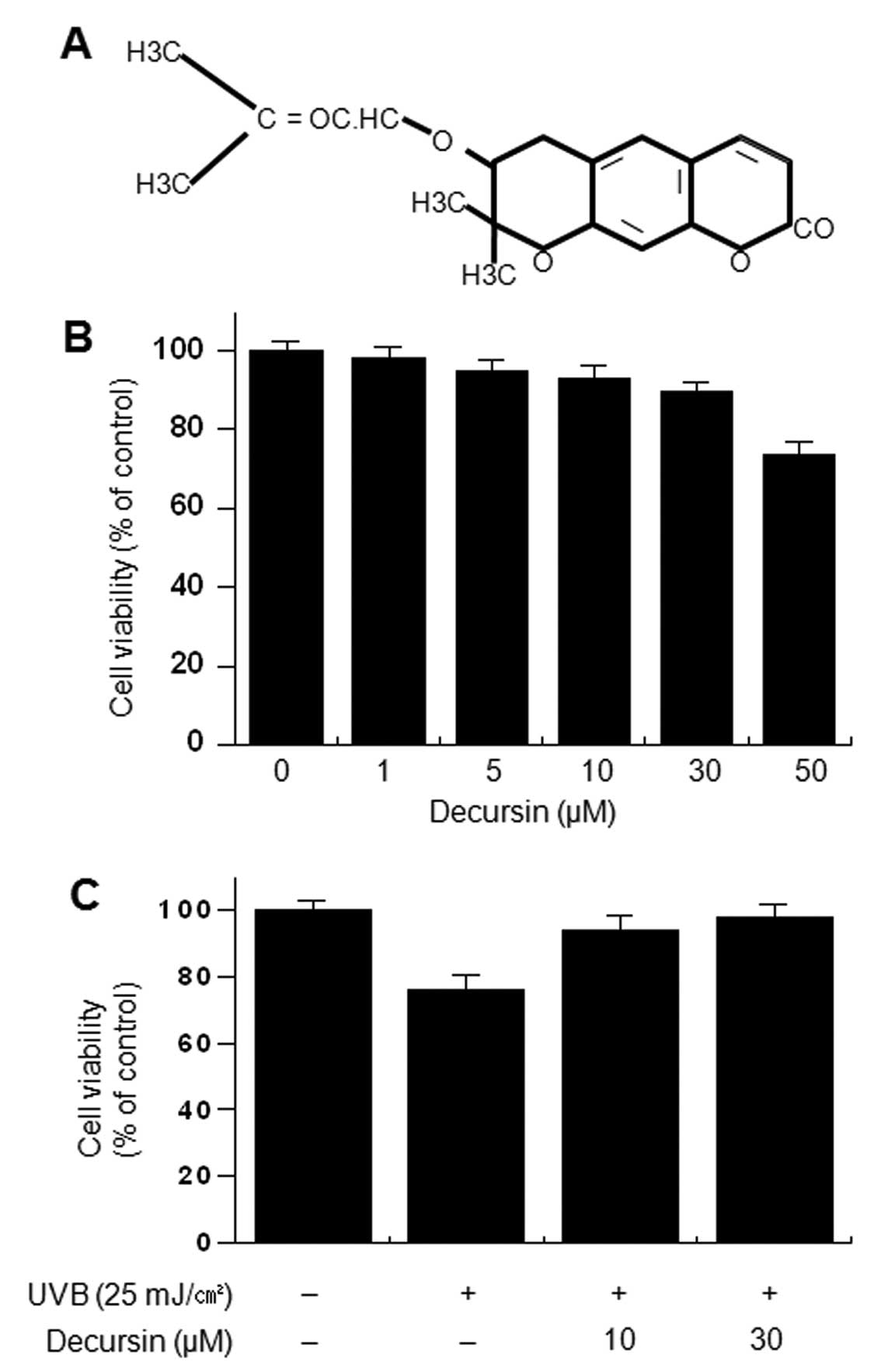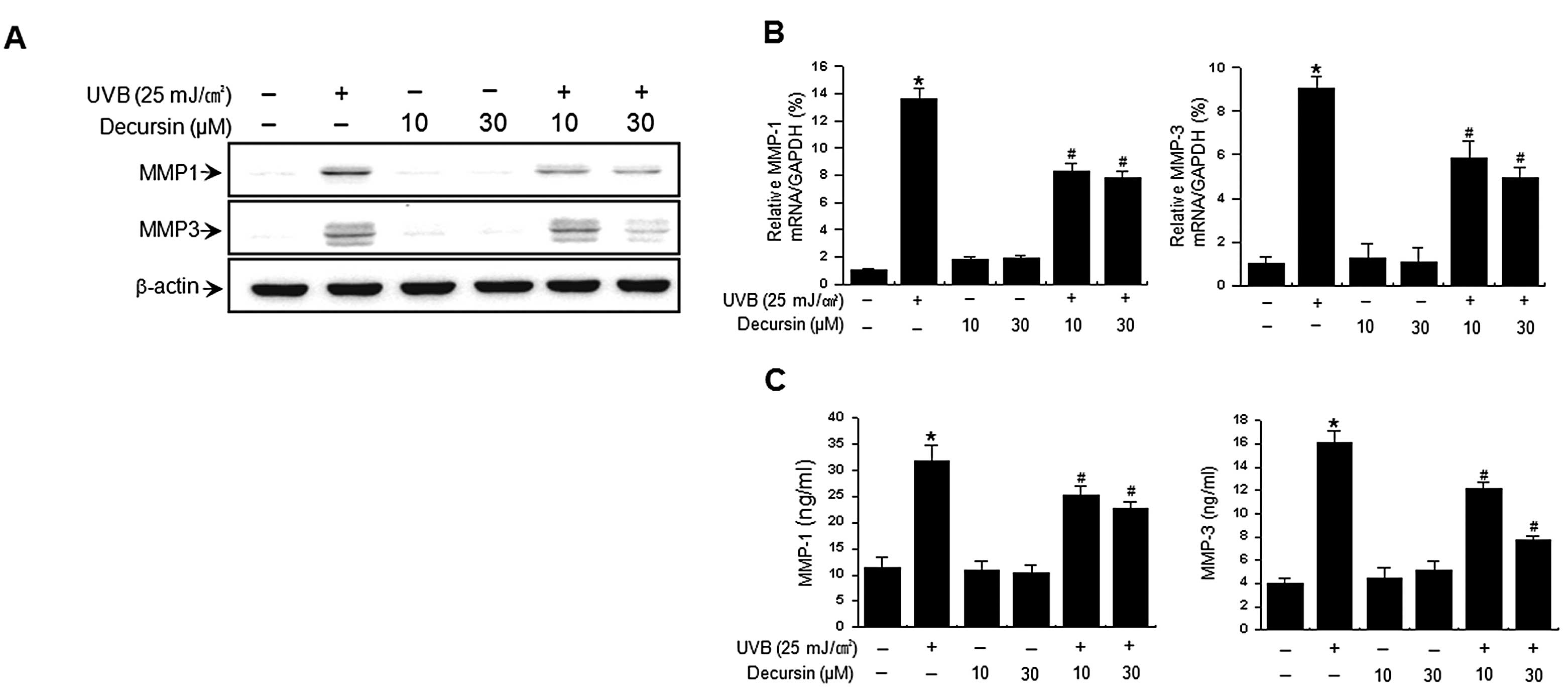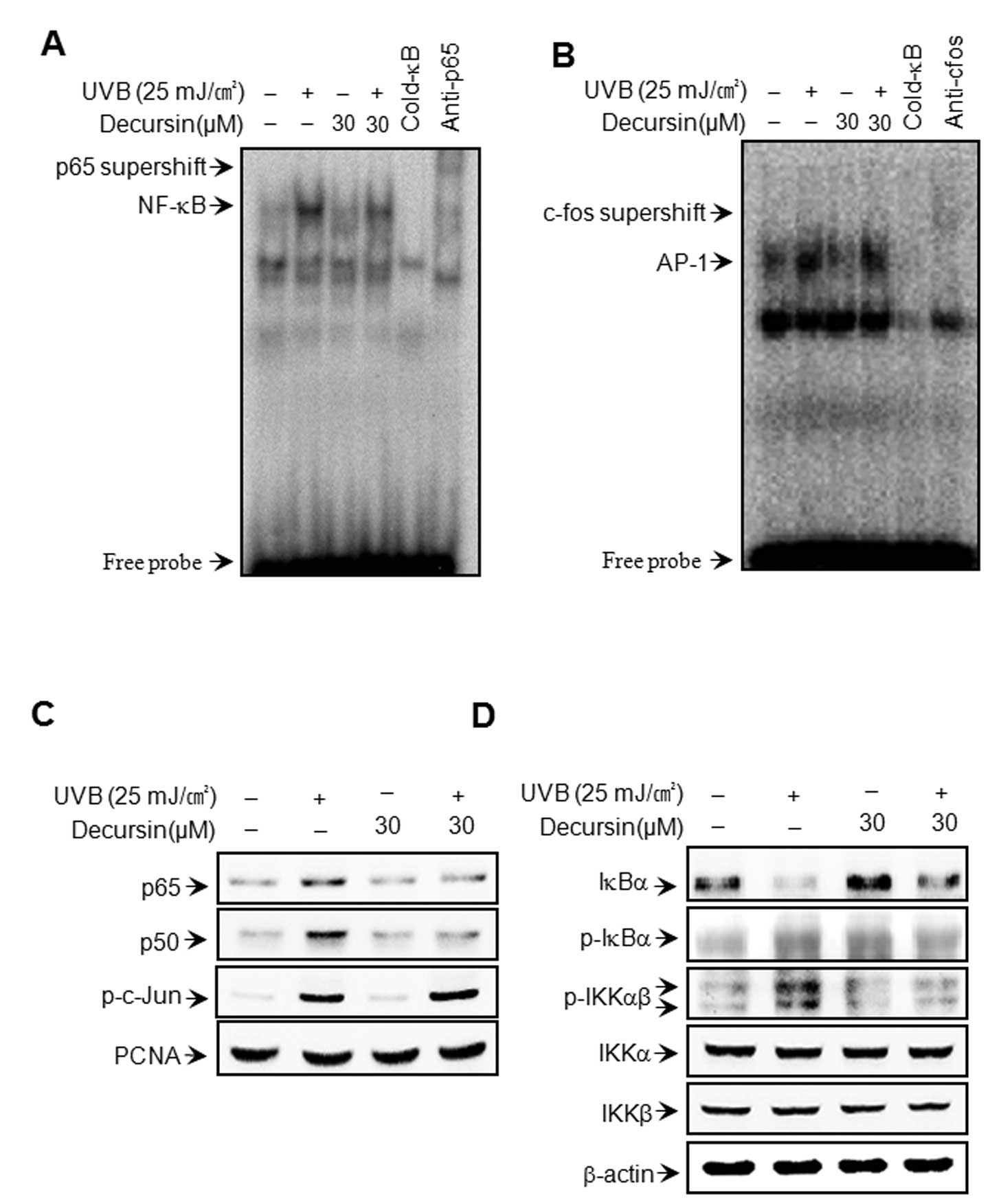|
1.
|
Ho JN, Lee YH, Park JS, et al: Protective
effects of aucubin isolated from Eucommia ulmoides against
UVB-induced oxidative stress in human skin fibroblasts. Biol Pharm
Bull. 28:1244–1248. 2005.PubMed/NCBI
|
|
2.
|
Scharffetter-Kochanek K, Brenneisen P,
Wenk J, et al: Photoaging of the skin from phenotype to mechanisms.
Exp Gerontol. 35:307–316. 2000. View Article : Google Scholar : PubMed/NCBI
|
|
3.
|
Knauper V, Lopez-Otin C, Smith B, Knight G
and Murphy G: Biochemical characterization of human collagenase-3.
J Biol Chem. 271:1544–1550. 1996. View Article : Google Scholar : PubMed/NCBI
|
|
4.
|
Pillai S, Oresajo C and Hayward J:
Ultraviolet radiation and skin aging: roles of reactive oxygen
species, inflammation and protease activation, and strategies for
prevention of inflammation-induced matrix degradation - a review.
Int J Cosmet Sci. 27:17–34. 2005. View Article : Google Scholar
|
|
5.
|
Brenneisen P, Sies H and
Scharffetter-Kochanek K: Ultraviolet-B irradiation and matrix
metalloproteinases: from induction via signaling to initial events.
Ann NY Acad Sci. 973:31–43. 2002. View Article : Google Scholar : PubMed/NCBI
|
|
6.
|
Rittié L and Fisher GJ: UV-light-induced
signal cascades and skin aging. Ageing Res Rev. 1:705–720.
2002.PubMed/NCBI
|
|
7.
|
Fisher GJ, Datta SC, Talwar HS, et al:
Molecular basis of sun-induced premature skin ageing and retinoid
antagonism. Nature. 379:335–339. 1996. View
Article : Google Scholar : PubMed/NCBI
|
|
8.
|
Chung JH, Seo JY, Lee MK, et al:
Ultraviolet modulation of human macrophage metalloelastase in human
skin in vivo. J Invest Dermatol. 119:507–512. 2002. View Article : Google Scholar : PubMed/NCBI
|
|
9.
|
Cooper SJ and Bowden GT: Ultraviolet B
regulation of transcription factor families: roles of nuclear
factor-kappa B (NF-kappaB) and activator protein-1 (AP-1) in
UVB-induced skin carcinogenesis. Curr Cancer Drug Targets.
7:325–334. 2007. View Article : Google Scholar : PubMed/NCBI
|
|
10.
|
Bell S, Degitz K, Quirling M, Jilg N, Page
S and Brand K: Involvement of NF-kappaB signalling in skin
physiology and disease. Cell Signal. 15:1–7. 2003. View Article : Google Scholar : PubMed/NCBI
|
|
11.
|
Karin M: The regulation of AP-1 activity
by mitogen-activated protein kinases. J Biol Chem. 270:16483–16486.
1995. View Article : Google Scholar : PubMed/NCBI
|
|
12.
|
Madrid LV, Mayo MW, Reuther JY and Baldwin
AS Jr: Akt stimulates the transactivation potential of the RelA/p65
subunit of NF-kappa B through utilization of the Ikappa B kinase
and activation of the mitogen-activated protein kinase p38. J Biol
Chem. 276:18934–18940. 2001. View Article : Google Scholar : PubMed/NCBI
|
|
13.
|
Ahn Q, Jeong SJ, Lee HJ, et al: Inhibition
of cyclooxygenase-2-dependent survivin mediates decursin-induced
apoptosis in human KBM-5 myeloid leukemia cells. Cancer Lett.
298:212–221. 2010. View Article : Google Scholar : PubMed/NCBI
|
|
14.
|
Yim D, Singh RP, Agarwal C, Lee S, Chi H
and Agarwal R: A novel anticancer agent, decursin, induces G1
arrest and apoptosis in human prostate carcinoma cells. Cancer Res.
65:1035–1044. 2005.PubMed/NCBI
|
|
15.
|
Jiang C, Guo J, Wang Z, et al: Decursin
and decursinol angelate inhibit estrogen-stimulated and
estrogen-independent growth and survival of breast cancer cells.
Breast Cancer Res. 9:R772007. View
Article : Google Scholar : PubMed/NCBI
|
|
16.
|
Kim WJ, Lee SJ, Choi YD and Moon SK:
Decursin inhibits growth of human bladder and colon cancer cells
via apoptosis, G1-phase cell cycle arrest and extracellular
signal-regulated kinase activation. Int J Mol Med. 25:635–641.
2010.PubMed/NCBI
|
|
17.
|
Kim WJ, Lee MY, Kim JH, Suk K and Lee WH:
Decursinol angelate blocks transmigration and inflammatory
activation of cancer cells through inhibition of PI3K, ERK and
NF-κB activation. Cancer Lett. 296:35–42. 2010.PubMed/NCBI
|
|
18.
|
Kim JH, Jeong JH, Jeon ST, et al: Decursin
inhibits induction of inflammatory mediators by blocking nuclear
factor-kappaB activation in macrophages. Mol Pharmacol.
69:1783–1790. 2006. View Article : Google Scholar : PubMed/NCBI
|
|
19.
|
Lee SH, Lee JH, Kim EJ, et al: A novel
derivative of decursin, CSL-32, blocks migration and production of
inflammatory mediators and modulates PI3K and NF-kappaB activities
in HT1080 cells. Cell Biol Int. 36:683–688. 2012. View Article : Google Scholar : PubMed/NCBI
|
|
20.
|
Lee YR, Noh EM, Jeong EY, et al:
Cordycepin inhibits UVB-induced matrix metalloproteinase expression
by suppressing the NF-kappaB pathway in human dermal fibroblasts.
Exp Mol Med. 41:548–554. 2009. View Article : Google Scholar : PubMed/NCBI
|
|
21.
|
Bradford MM: A rapid and sensitive method
for the quantitation of microgram quantities of protein utilizing
the principle of protein-dye binding. Anal Biochem. 72:248–254.
1976. View Article : Google Scholar : PubMed/NCBI
|
|
22.
|
Fisher GJ, Kang S, Varani J, et al:
Mechanisms of photoaging and chronological skin aging. Arch
Dermatol. 138:1462–1470. 2002. View Article : Google Scholar : PubMed/NCBI
|
|
23.
|
Jacobs MD and Harrison SC: Structure of an
IkappaBalpha/NF-kappaB complex. Cell. 95:749–758. 1998. View Article : Google Scholar : PubMed/NCBI
|
|
24.
|
Regnier CH, Song HY, Gao X, Goeddel DV,
Cao Z and Rothe M: Identification and characterization of an
IkappaB kinase. Cell. 90:373–383. 1997. View Article : Google Scholar : PubMed/NCBI
|
|
25.
|
Mercurio F, Zhu H, Murray BW, et al: IKK-1
and IKK-2: cytokine-activated IkappaB kinases essential for
NF-kappaB activation. Science. 278:860–866. 1997. View Article : Google Scholar : PubMed/NCBI
|
|
26.
|
Karin M: How NF-kappaB is activated: the
role of the IkappaB kinase (IKK) complex. Oncogene. 18:6867–6874.
1999. View Article : Google Scholar : PubMed/NCBI
|
|
27.
|
Chung TW, Moon SK, Chang YC, et al: Novel
and therapeutic effect of caffeic acid and caffeic acid phenyl
ester on hepatocarcinoma cells: complete regression of hepatoma
growth and metastasis by dual mechanism. FASEB J. 18:1670–1681.
2004. View Article : Google Scholar : PubMed/NCBI
|
|
28.
|
Eberhardt W, Huwiler A, Beck KF, Walpen S
and Pfeilschifter J: Amplification of IL-1 beta-induced matrix
metalloproteinase-9 expression by superoxide in rat glomerular
mesangial cells is mediated by increased activities of NF-kappa B
and activating protein-1 and involves activation of the
mitogen-activated protein kinase pathways. J Immunol.
165:5788–5797. 2000.
|
|
29.
|
Uitto J: Connective tissue biochemistry of
the aging dermis. Age-related alterations in collagen and elastin.
Dermatol Clin. 4:433–446. 1986.PubMed/NCBI
|
|
30.
|
Gilchrest BA: A review of skin ageing and
its medical therapy. Br J Dermatol. 135:867–875. 1996. View Article : Google Scholar : PubMed/NCBI
|
|
31.
|
Chung JH, Hanft VN and Kang S: Aging and
photoaging. J Am Acad Dermatol. 49:690–697. 2003. View Article : Google Scholar
|
|
32.
|
Varani J, Perone P, Fligiel SE, Fisher GJ
and Voorhees JJ: Inhibition of type I procollagen production in
photodamage: correlation between presence of high molecular weight
collagen fragments and reduced procollagen synthesis. J Invest
Dermatol. 119:122–129. 2002. View Article : Google Scholar
|
|
33.
|
Chung JH, Seo JY, Choi HR, et al:
Modulation of skin collagen metabolism in aged and photoaged human
skin in vivo. J Invest Dermatol. 117:1218–1224. 2001. View Article : Google Scholar : PubMed/NCBI
|
|
34.
|
Lloyd RE, Larson RA, Adair TL and Tuveson
RW: Cu(II) sensitizes pBR322 plasmid DNA to inactivation by UV-B
(280–315 nm). Photochem Photobiol. 57:1011–1017. 1993.PubMed/NCBI
|
|
35.
|
Brenneisen P, Wenk J, Wlaschek M, Krieg T
and Scharffetter-Kochanek K: Activation of p70 ribosomal protein S6
kinase is an essential step in the DNA damage-dependent signaling
pathway responsible for the ultraviolet B-mediated increase in
interstitial collagenase (MMP-1) and stromelysin-1 (MMP-3) protein
levels in human dermal fibroblasts. J Biol Chem. 275:4336–4344.
2000.
|
|
36.
|
Kim JK, Mun S, Kim MS, Kim MB, Sa BK and
Hwang JK: 5,7-Dimethoxyflavone, an activator of PPARalpha/gamma,
inhibits UVB-induced MMP expression in human skin fibroblast cells.
Exp Dermatol. 21:211–216. 2012. View Article : Google Scholar : PubMed/NCBI
|
|
37.
|
Chiang HM, Chen HC, Lin TJ, Shih IC and
Wen KC: Michelia alba extract attenuates UVB-induced
expression of matrix metalloproteinases via MAP kinase pathway in
human dermal fibroblasts. Food Chem Toxicol. 50:4260–4269. 2012.
View Article : Google Scholar
|
|
38.
|
Bakiri L, Matsuo K, Wisniewska M, Wagner
EF and Yaniv M: Promoter specificity and biological activity of
tethered AP-1 dimers. Mol Cell Biol. 22:4952–4964. 2002. View Article : Google Scholar : PubMed/NCBI
|
|
39.
|
Chen FE and Ghosh G: Regulation of DNA
binding by Rel/NF-kappaB transcription factors: structural views.
Oncogene. 18:6845–6852. 1999. View Article : Google Scholar : PubMed/NCBI
|
|
40.
|
Adhami VM, Afaq F and Ahmad N: Suppression
of ultraviolet B exposure-mediated activation of NF-kappaB in
normal human keratinocytes by resveratrol. Neoplasia. 5:74–82.
2003. View Article : Google Scholar : PubMed/NCBI
|
|
41.
|
Tanaka K, Hasegawa J, Asamitsu K and
Okamoto T: Prevention of the ultraviolet B-mediated skin photoaging
by a nuclear factor kappaB inhibitor, parthenolide. J Pharmacol Exp
Ther. 315:624–630. 2005. View Article : Google Scholar : PubMed/NCBI
|
|
42.
|
Bond M, Baker AH and Newby AC: Nuclear
factor kappaB activity is essential for matrix metalloproteinase-1
and -3 upregulation in rabbit dermal fibroblasts. Biochem Biophys
Res Commun. 264:561–567. 1999. View Article : Google Scholar : PubMed/NCBI
|
|
43.
|
Chung JH: Photoaging in Asians.
Photodermatol Photoimmunol Photomed. 19:109–121. 2003. View Article : Google Scholar
|
|
44.
|
Liu Q, Loo WT, Sze SC and Tong Y: Curcumin
inhibits cell proliferation of MDA-MB-231 and BT-483 breast cancer
cells mediated by down-regulation of NFkappaB, cyclinD and MMP-1
transcription. Phytomedicine. 16:916–922. 2009. View Article : Google Scholar : PubMed/NCBI
|
|
45.
|
Kim SY, Jung SH and Kim HS: Curcumin is a
potent broad spectrum inhibitor of matrix metalloproteinase gene
expression in human astroglioma cells. Biochem Biophys Res Commun.
337:510–516. 2005. View Article : Google Scholar : PubMed/NCBI
|
|
46.
|
Shim JS, Kwon YY, Han YS and Hwang JK:
Inhibitory effect of panduratin A on UV-induced activation of
mitogen-activated protein kinases (MAPKs) in dermal fibroblast
cells. Planta Med. 74:1446–1450. 2008. View Article : Google Scholar : PubMed/NCBI
|
|
47.
|
Bae JY, Choi JS, Choi YJ, et al:
(−)Epigallocatechin gallate hampers collagen destruction and
collagenase activation in ultraviolet-B-irradiated human dermal
fibroblasts: involvement of mitogen-activated protein kinase. Food
Chem Toxicol. 46:1298–1307. 2008.
|
|
48.
|
Yao J, Xiong S, Klos K, et al: Multiple
signaling pathways involved in activation of matrix
metalloproteinase-9 (MMP-9) by heregulin-beta1 in human breast
cancer cells. Oncogene. 20:8066–8074. 2001. View Article : Google Scholar : PubMed/NCBI
|
|
49.
|
Ruhul Amin AR, Senga T, Oo ML, Thant AA
and Hamaguchi M: Secretion of matrix metalloproteinase-9 by the
proinflammatory cytokine, IL-1beta: a role for the dual signalling
pathways, Akt and Erk. Genes Cells. 8:515–523. 2003.PubMed/NCBI
|
|
50.
|
Weng CJ, Chau CF, Hsieh YS, Yang SF and
Yen GC: Lucidenic acid inhibits PMA-induced invasion of human
hepatoma cells through inactivating MAPK/ERK signal transduction
pathway and reducing binding activities of NF-kappaB and AP-1.
Carcinogenesis. 29:147–156. 2008. View Article : Google Scholar : PubMed/NCBI
|














